|
Editorial
|
Press Releases
|
Book Reviews
|
Fragments
Artifacts: The Exodus Revelation I
The Journey: Ireland I
|
Giants of Ireland
|
The Lord of the Rings Cipher I
Register
for our Hall of Records Newsletter
Questions? Comments? Suggestions? Advertising? Press Releases?
Contact us!
Introduction
|
J.R.R. Tolkien
|
The Song of Creation
|
The Shaping of Earth
Two Lamps, Two Trees, Two Witnesses
|
The War of the Jewels
|
Morgoth's Ring
LOTR_Cipher Notes
|
LOTR_Cipher Links
|
LOTR_Cipher Books
|
LOTR_Cipher Audio
LOTR_Cipher Video
|
LOTR_Cipher Collectibles

|
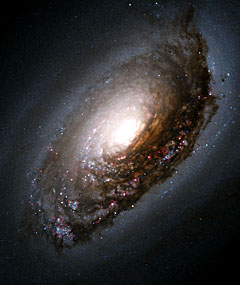
|
|
|
The "Evil Eye" Galaxy. Melkor's contribution to the divine music that created the universe was among other things, primarily the concept of gravity, a sort of "cosmic selfishness" where the tendency is for matter, instead of spreading out and being "free", is instead to gather into larger and more dominant clusters. This was essentially the principle that Melkor acted out as Morgoth, attempting to bring all things in Middle Earth under his control. However, as with the universe, the other beings of Arda resisted his attempts to control them, and most succeeded, but all were effected by his power, their destinies ultimately strongly affected by his presence just as the paths of the planets are largely determined by the sun's gravity. As a result, no one was ever truly "free", nor was Melkor ever truly completely in control. The two were balanced against each other, exactly as Il�vatar had planned in the beginning. "Morgoth's Ring" then, in a sense, could be said to be the entire universe, or at least the dominant principles, such as gravity, to be found therein.
Image from
The European Homepage For The NASA/ESA Hubble Space Telescope.
|
|
And so we come full circle in our understanding of Morgoth's role in the grand scheme of the Middle Earth universe. Morgoth fulfills the role of Satan in the Middle Earth
mythopoeia,
the ultimate
trickster
whose creative powers turn all to darkness, the eternal accuser who forces the power of good to adopt a stance of eternal vigilance against his predations. Initially the greatest of the manifestations of Il�vatar, Morgoth became his greatest opponent, seeking to undermine his will and destroy all that was good in his Creation. All along, however, Morgoth was only doing what Eru had manifested him to do — to inculcate into the universe of Arda the principle of uncertainty, of entropy, and of death so that good and life and light would stand in stark contrast and be appreciated all the more. Like the great black hole at the center of our galaxy, Morgoth devoured all life and light that came within his evil grasp. But despite his wickedness, life continued and flourished as his evil was turned to fulfill Il�vatar's good purpose.
Some have wondered why J.R.R. Tolkien's son Christopher Tolkien entitled one of his father's posthumously published collections of ancillary writings on the subject of Middle Earth
Morgoth's Ring
because, unlike his prot�g�
Sauron,
Morgoth did not have an all-powerful
"ring".
Tolkien's son saw into his father's mind's eye, however, and discerned that his father's concept of Sauron was one who was merely repeating the same pattern that his master Morgoth had embodied, of misusing his power to encircle and enslave others. Morgoth used all of the power that had been bestowed upon him by Il�vatar not to create original things of beauty and worth, but to steal and control the works of others — to ensnare and enslave them to his dark will. And as a result, in Tolkien's sub-creation (as well as God's original Creation), the universe appears to be based upon the principle of the spiral — specifically, straight lines bent into spirals. This is essentially how things work, from the atom all the way to a galaxy — all things in orbit around a central core that always seeks to devour them. This is the principle that Morgoth introduced into the universe in the great song of creation, and thus, in a sense, Morgoth did indeed have a ring — the entire universe, which he perpetually sought to bend to his will. However, as would happen to Sauron ages later, control of that ring was taken away from him and, in the end, the universe that he corrupted will be destroyed and replaced by a new universe, all of Morgoth's evil power being destroyed with it. Tolkien-Online.com summarizes it best:
Morgoth's Ring takes its name from a passage in one of Professor Tolkien's late essays "Notes on Motives in the Silmarillion", in which he surmises that while Sauron invested much of his power in "the One Ring", Morgoth invested his power (hence his "corruption") into the very "physical constituents of the Earth" (MR pg 394). Hence, "the whole of Middle-earth was Morgoth's Ring" (MR pg 400).35
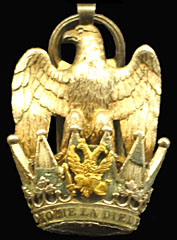
|
|
|
The insignia of The Imperial Order of the Iron Crown, established in 1805 by
Napoleon. Note the double-headed eagle on the front plate of the crown, and the iron ring surrounding the eagle's head. This insignia incorporates all the major symbols of worldly power, a likely inspiration for Morgoth's crown.
Image from
Wikipedia.
|
|
Though Tolkien considered the whole universe to be
"Morgoth's Ring",
if Morgoth did have a physical "ring", it would have been the terrible iron crown he wore, in which he had set the Silmarilli that he had stolen from F�anor. Though setting the great jewels in the crown burned and blackened his hands permanently, and the wearing of the crown filled him with a deadly weariness, he endured the pain apparently because the Silmarilli contained within them a great power that he wished to control and use for his own dark purposes.
Morgoth's ring, a ring of iron that he wore not upon his finger, but upon his head, is perhaps the most powerful and meaningful cipher in Tolkien's symbolic universe, as it combined both the original fire of creation set in the Silmarilli, and Morgoth's own iron will, symbolized by the ring of iron which, for a time, controlled them. Thus, though Morgoth was not able to bend and control all of creation to his own will, he was able to do so symbolically through the setting of the jewels of creation in his crown.
But would Morgoth have taken such a terrible risk just so that he could only symbolically control the universe? Unlikely. Obviously Tolkien had something more sinister in mind when he decided to have Morgoth steal the Silmarilli and set them in his crown of iron. Perhaps Tolkien knew of a time when there was a king on earth who controlled three powerful jewels and set them in a ring of iron, through which he was, at least for a time, able to rule the world.
The riddle once again requires a look back at the Greek legend of Prometheus, the titan. Prometheus, who had stolen the secret of fire from the gods of heaven and given it to mankind, had earned the wrath of Zeus, who ordered him chained for all eternity to
Mt. Elburz
—
|
|
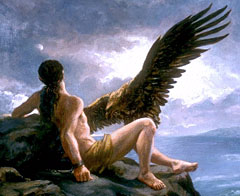
|
|
|
Prometheus chained to the twin-peaked
Mt. Elburz
in the
Caucasus Mountains,
while the eagle of Zeus eats his self-regenerating liver. Prometheus was chained to the mountain for 30,000 years until Zeus relented and had Hercules release him. For ever after, the concept of a self-empowering individual, associated with an iron ring and an eagle, has been the symbol of choice for would-be dictators worldwide. Interestingly, the name Elburz comes from the ancient Avestan (Persian) term
Hara Berezaiti
which means "high watchpost",and was believed to be the center of the universe, around which all stars revolved. This twin-peaked "high watchpost" associated with the eagle of Zeus may be the ultimate inspiration for the double-headed eagle which shows up on the insignia of Napoleon's Imperial Order of the Iron Crown.
Image from
Encyclopedia Mythica.
|
a
twin-peaked mountain
in the
Caucasus Mountains
that lies south of modern Russia and northwest of modern Iran. And as part of his punishment, every day the eagle of Zeus would descend upon Prometheus and devour his liver, which regenerated the next day so that the eagle could feast once more.
However, Prometheus' mother, the nymph
Asia,
in return for her son's release, gave the gods the secret of eternal control of the universe, without which they could one day be overthrown. Secure in their power, they could then release Prometheus from his bonds without fear. However, since Zeus had decreed that Prometheus would be chained to the Caucasus forever, he realized that he could not undo his own decree, so in order to get around the letter of the law he constructed an
iron ring
made of the chain that had bound Prometheus to the rock of the mountain, and then set a chip of the rock Prometheus had been bound to into the ring so Prometheus would still be "bound to the rock" of Mt. Caucasus. Prometheus agreed, and even liked the ring, and thereafter mankind wore rings with inset stones to honor Prometheus, who had gone out of his way to help them. And though the story seems to have a happy ending, the central theme of the story is that the eternal control of the universe is somehow mysteriously related to an iron ring set with a special stone.

|
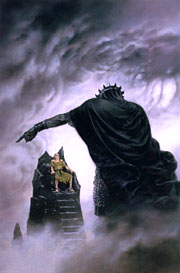
|
|
|
H�rin,
a human hero of the First Age, who successfully opposed Morgoth for most of his life until his capture after a heroic struggle against
Gothmog,
Lord of the Balrogs of Morgoth, whose entire personal guard of trolls he had dispatched single-handedly during the
N�rnaeth Arnoediad,
"The Battle of Unnumbered Tears", the Fifth Battle of the Wars of Beleriand between the elves and Morgoth.
Morgoth's forces captured H�rin but, unable to break Hurin's will and force him to reveal the location of Gondolin, a secret fortress of the elves, Morgoth cursed him and sat him, bound, on a high peak from where he must watch evil overtake his wife and children. This event has clear similarities to the story of Prometheus, except the roles are reversed, where evil is seen as binding good to the top of a tall mountain. In either case it is a classic image of the iron-crown-wearing tyrant attempting to enforce his will upon humanity.
Image from
A Silmarillion Chronology.
|
|
However, in the myth of Prometheus, like the story of the fallen angels in The Book of Enoch, Prometheus' "help" of mankind usually left them worse off than they were before. This is because Prometheus' (i.e., Satan's) "gifts" to mankind came in the form of technology which, though this knowledge helped mankind to be more self-sufficient in the short term, in the long term it merely led to the centralization of power, and eventually to tyranny, as the few were able to use technology to control the many. Moreover, with the introduction of military technology, Prometheus' "gifts" merely aided mankind in his ability to kill his fellow man more efficiently, leaving them worse off than they were before. In retrospect, it is clear that these "gifts" were in fact diabolically clever schemes the fallen angels devised in order not to help, but to enslave mankind.
This "iron crown of tyranny" theme was one of the strongest themes in Tolkien's works, where Tolkien believed that technological "progress" inevitably led to the iron crown of the power of evil.36 His hatred of technological progress stemmed largely out of the industrialization of his favorite childhood haunts, which were once scenes of sylvan beauty that were polluted and destroyed by the building of factories. His experiences in the trenches in World War I greatly magnified his hatred of industrialization, as it merely enhanced mankind's ability to kill their fellow men with machinelike efficiency, and destroy the environment in the process. Morgoth, in this sense, was Tolkien's mythological embodiment of what happens when absolute power corrupts absolutely — in the quest for absolute power, the would-be tyrant destroys everything good in the process, corroding and corrupting everyone and everything around him until there is nothing left worth conquering. Morgoth grew out of Tolkien's conception of Satan, Hitler, and of every would-be dictator who ever strove to grasp for the iron crown of absolute power. Morgoth's Ring, then, was his iron crown, a coronet of base metal festooned with stolen jewels, a fitting crown for the highest of the low. Unlike Sauron's ring, the Iron Crown possessed no inherent power, but its symbolism is none the less powerful, symbolizing the power of evil in the universe that radiated from and found its ultimate source in Morgoth.

|
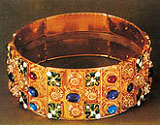
|
|
|
The Iron Crown of Lombardy,
so called from the narrow band of iron set on the inside of the crown. Tradition has it that the nail is one of those used to crucify Christ, though the exact purpose of the narrow band of iron may originally have been esoteric in nature. This crown may have been largely the inspiration for Morgoth's iron crown.
|
|
But what if Morgoth's "ring" did indeed have a great power of its own? Was there a prominent "iron crown" in the history of Europe that was believed to have unusual powers, a crown that may have been the inspiration for Morgoth's iron crown? In fact, one of the most famous crowns in European history fits that description perfectly:
The Iron Crown of Lombardy:
The Iron Crown is so called from a narrow band of iron about one centimeter (three-eighths of an inch) within it, said to be beaten out of one of the nails used at the crucifixion. According to tradition, the nail was first given to
Emperor Constantine I
by his mother
Helena,
who discovered the cross.
How it fell into the hands of the Lombard kings, Germanic conquerors of northern Italy, is not well explained.
Theodolinda,
the queen of Lombards, in many legends is said to have been involved in its discovery.
Some scholars posit that there were, in fact, many nails being circulated at the time. Almost thirty European countries lay claim to a holy nail. Constantinople seems to have made liberal use of them: "Empress Helena, who seems to have spent much of her reign locating holy relics, once cast a nail from the Holy Cross into the sea to calm a storm. Another was fitted to the head of a statue of the Emperor Constantine, while a third was incorporated into his helmet." A fourth nail was melted down and molded into a bit for his horse.
In how the nail in the Iron Crown in particular reached the Lombards: "Constantine also understood the value of these objects in diplomacy." Several were sent off to various dignitaries, one of whom was Princess Theodolinda. "She used her nail as part of her crown, the famous Iron Crown of Lombardy." She later donated the crown to the Italian church at Monza in 628, where it is preserved as a holy relic. It was later used in Charlemagne's coronation. The crown became one of the symbols of the Kingdom of Lombards and later of the medieval Kingdom of Italy.
The outer circlet of the crown is of six gold and enamel segments of beaten gold, joined together by hinges and set with precious stones that stand out in relief, in the form of crosses and flowers. Its small size and hinged construction have suggested to some that it was originally a large armlet or perhaps a votive crown. Probably the little size of the crown was caused by a readjustment after the loss of two segments, as proven in historical documents.37
The
Lombards,
also known as the Longbardi (lit., "long beards") were a Nordic or Germanic people who had emigrated south sometime around the sixth century AD in search of greener pastures, finally settling in the region now known as
Lombardy,
in what is now northern Italy, in 568.38 The most famous wearer of the Iron Crown of Lombardy was the legendary Holy Roman Emperor
Charlemagne,
who conquered the region in 774 and for a time made it part of his empire.
Other famous emperors since the time of Charlemagne also wore it, including such notables as
Otto I,
Henry IV,
Frederick I Barbarossa,
(whose conquests would later inspire one
Adolph Hitler),
and even
Napoleon
who, when the Cardinal Archbishop of Milan attempted to crown him, took the crown and placed it upon his own head, issuing the stern warning, "God gives it to me, beware those who touch it!"39
Interestingly, at least two segments have disappeared somewhere along the line, causing the crown to be remade into a smaller version which no longer properly fits, being more the size of a collar than a crown. It is interesting that the crown is now the size of a collar, because the final time that Morgoth was captured by the Valar in The Silmarillion, his iron crown was beaten into a collar, his symbol of power turned into a symbol of defeat. The fact that the iron crown has had sections removed from it sometime in the ancient past was probably part of the inspiration for Tolkien's very important tale of Beren and L�thien, wherein the hero Beren recovers one of the Silmarilli by cutting it from Morgoth's crown. Through this most personal of ciphers, Tolkien may be intimating that the Iron Crown of Lombardy once held two (or three?) jewels of great importance that were removed from it in ancient times, one of which he himself may have intimate knowledge of. Could it be that the Iron Crown of Lombardy held one or more of the missing tsohar stones, which were later removed and hidden away in order to be put to more practical (or diabolical) use in our near future?

|
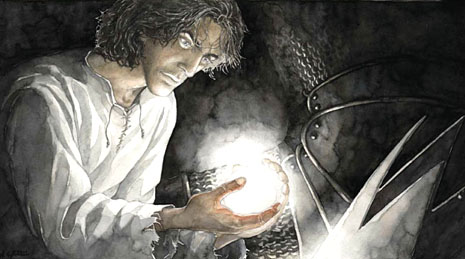
|
|
Beren
recovering a Silmaril from the iron crown of Morgoth. The love story of Beren and
L�thien,
called
The Lay of Leithian
("The Song of Release from Bondage") had intense personal meaning for Tolkien, indicating that it may contain the most important cipher of all.
|
Perhaps the most important tale of the cycle, at least from Tolkien's own personal perspective, is the Tale of
Beren and
L�thien.
Formally called
The Lay of Leithian
("The Song of Release from Bondage"),
this beautiful story tells how a nobleman, Beren, son of
Barahir
of the house of
B�or
(the smallest of
The Three Houses of the Edain)
defied all odds to retrieve one of the Silmarilli from the iron crown of Morgoth himself.
L�thien Tin�viel
was the daughter of
Thingol,
king of the elves of
Nargothrond,
and
Melian, a
Maia of great power who assumed human form in order to marry the elf she loved. L�thien, their offspring, was thus the most beautiful woman in the world.
|
|
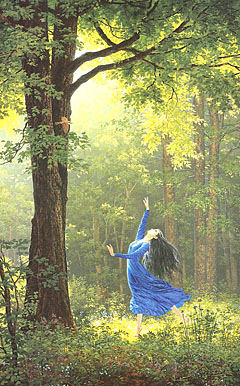
|
|
|
L�thien Tin�viel (lit., "Enchanting daughter of the starry twilight" or "Enchanting Nightingale"), depicted dancing in the trees and groves of her father's palace. L�thien was the daughter of the elven king Thingol and a Maia named Melian, making L�thien half-divine. As a result, L�thien was exceptionally beautiful and charming, even for an elf maid. Tolkien's concept of L�thien was based upon the beauty and personality of his lovely wife,
Edith,
though her name and character may contain even deeper, hidden meanings.
Image from
A Silmarillion Chronology.
|
One day, fleeing from Morgoth's armies, Beren happened upon L�thien, who was singing and dancing in the meadows near her father's palace. Deeply smitten with her exceptional beauty, Beren secretly sought to meet with her, to proclaim the great love he felt for her. One day he finally worked up the nerve to approach her, and she, similarly smitten, also fell deeply in love with him, and their fate was sealed.
Though L�thien loved Beren, her father King Thingol did not, and would have killed Beren had he not sworn to L�thien that he would not. However, Beren was still a man and thus considered to be inferior to the immortal elves, so Thingol gave him a terrible quest to perform in return for his daughter's hand: Beren must cut one of the Silmarilli from the iron crown of Morgoth and bring it back to Thingol. And though such a feat was impossible short of divine intervention, and though a Silmaril would be the greatest prize on Earth, so great was his love for his daughter that Thingol still felt that Beren was getting the better of the deal.
After a series of epic adventures, with the help of L�thien and a mighty hound of
Valinor
named
Huan,
against all odds Beren managed to cut a Silmaril from the iron crown of Morgoth. And though the great jewel eventually reached King Thingol by another means, Beren and L�thien never married, Beren dying from his wounds, and L�thien dying from grief. When L�thien reached the Halls of Mandos, however, she sang a song so beautiful that even Mandos was moved to pity, and she and Beren were allowed to return to earth to live out their natural, mortal lives as husband and wife. And it was from this union that came forth the greatest of the kings of men of old, the great line of
Aragorn,
the once and future king. But that is a tale for a different time.
Tolkien's wife,
Edith,
whom he loved dearly, was his inspiration for the beautiful L�thien. Tolkien so closely identified himself and his wife with Beren and L�thien, in fact, that he had the names Beren and L�thien literally inscribed on their tombstone. Why did Tolkien associate Edith and himself with Beren and L�thien? Could this be the most important — and most cryptic — cipher of all?
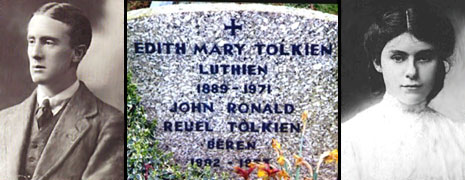
|
|
The gravestone of J.R.R. and Edith Tolkien, with images of J.R.R. and Edith Tolkien from around the time they first fell in love. The love story of Beren and L�thien was based in part on their on again/off again romance, Edith being Tolkien's inspiration for the lovely elf maid, L�thien. So closely did Tolkien identify himself and Edith with Beren and L�thien, that he literally had their names inscribed on their tombstone.
Image from
Arwen-Undomiel.com.
|
The story of Beren and L�thien has clear antecedents in several well-known love stories, such as
Tristan and Isolde,
Romeo and Juliet, and
Diarmuid and Gr�inne.
However, the addition of a magical
"jewel of great price"
is unusual to this genre, and indicates that Tolkien may have been using the love story as a vehicle to communicate some higher truth. Perhaps he saw Beren and L�thien as a sort of second Adam and Eve, retrieving a stone that Satan had stolen "in the beginning", in order to somehow reconcile themselves with their Father, God? If so, how would he and Edith fit into this scenario? Was it simply the romantic fairy tale aspect that they embraced, or was there some deeper secret that Tolkien darkly hinted at but dared not fully explain, waiting for someone else to decipher it at the time appointed?

|
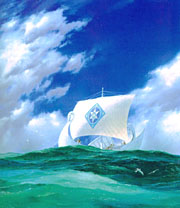
|
|
|
E�rendil
sailing the elven ship
Vingil�t�
to
Aman
with the recovered Silmaril, seeking help from the Valar against the power of Morgoth. Normally traveling to Aman was impossible to all but those the Valar wished to find them, but E�rendil was able to use the power of the Silmaril in order to overcome the guards and wards of the Valar and find the Blessed Land.
Image from
A Silmarillion Chronology.
|
|
After a series of disasters brought on by the curse of F�anor, which affected everyone who became involved with the recovered Silmaril, a mortal man named
E�rendil,
(lit., "lover of the sea"), came into possession of it via his wife
Elwing,
the grand-daughter of Beren and L�thien. E�rendil is considered to be one of the most important characters in Tolkien's mythology due to his critical role as messenger between the world of "the gods" and of men in Tolkien's Middle Earth mythopoeia. This intercession took place when E�rendil and Elwing crossed over the sea in their ship, the
Vingil�t�
("Foam Flower"), in search of the land of
Aman,
which had been closed to mortals such as E�rendil, and to those of the Noldor who had remained unrepentant. However, with the light of the Silmaril that was fastened to his brow, they were able to find the hidden way to Valinor, where they interceded with the Valar on behalf of mortal men and of the exiled elves to aid them against the overwhelming power of Morgoth.
|
|
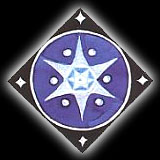
|
|
|
E�rendil's shield device, featuring the Silmaril he recovered from Morgoth. Interestingly, the Silmaril was six-sided, in appearance just like the Tuaoi stones of Cayce's Atlantis. Cayce was very much in vogue during Tolkien's time, particularly to old-fashioned Victorian types such as Tolkien, and it is very likely that Cayce was one of Tolkien's influences.
Image from
Arwen-Undomiel.com.
|
Though the penalty for visiting Valinor without permission was death for mortals, Manw� deemed the cause just, and gave E�rendil and Elwing the opportunity to live out their lives as mortals in Aman, or live eternally as elves. They chose the latter, and Elwing was given a tall white tower in which to live forever by the sea she loved. E�rendil's fate was much more dramatic, however. His ship, the Vingil�t�, was made to soar in the heavens forever, with E�rendil standing at its prow with the Silmaril fastened to his forehead, fated to soar the heavens forever as a great star.
This great star was what we understand today as the planet
Venus,
the orbit of which occasionally makes it appear to set ahead of the sunrise, and rise after the sunset. Interestingly, this apparent
apotheosis
of E�rendil was inspired by a mere two lines in an old Anglo-Saxon poem called
"The Crist of Cynewulf".
An understanding of this cryptic passage is crucial to understanding Tolkien's cipher, as Tolkien's own personal "Christian mythology" began to crystallize when he encountered this poem, particularly two passages therein that struck him forcibly:
Hail Earendel, brightest of angels
above the middle-earth sent unto men.
Earendel is glossed by the Anglo-Saxon dictionary as "a shining light, ray", but here it clearly has some special meaning. Tolkien himself interpreted it as referring to
John the Baptist,
but he believed that "Earendel" had originally been the name for the star presaging the dawn, that is, Venus. He was strangely moved by its appearance in the Cynewulf lines. "I felt a curious thrill," he wrote long afterwards, "as if something had stirred in me, half wakened from sleep. There was something very remote and strange and beautiful behind those words, if I could grasp it, far beyond ancient English.40
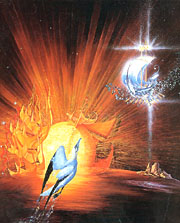
|
|
|
E�rendil's ship, Vingil�t�, transformed into a heavenly ship, and his wife, Elwing, transformed into a seagull. In Tolkien's Middle Earth mythopoeia, the planet Venus is actually E�rendil on his ship, with the Silmaril affixed to his forehead.
Image from
A Silmarillion Chronology.
|
|
This Earendel poem, which was about an angel who was also the morning star, was based upon an Anglo-Saxon Christian hymn.41 The name Earendel in Old English basically means "star" and, not surprisingly, the variant name Auriwandalo is the name of a Lombardic prince, of the same people who held the Iron Crown of the Lombards, which we believe was the inspiration for the iron crown of Morgoth from which Beren had cut one of the Silmarilli. E�rendil's starry provenance is further confirmed in Norse mythology by a character in the
Prose Edda
named Aurvandil, whose frozen toe was thrown into heaven by Thor to become a prominent star. Some scholars believe that the reference is to John the Baptist, who is likened to a great shining light who heralded, and will herald again the coming of Christ.42 Tolkien may have added the intercessory aspect of the E�rendil character based upon Jesus' cryptic statement that occurs near both the beginning and the end of the Book of Revelation: "I, Jesus, have sent My angel to testify to you these things in the churches. I am the Root and the Offspring of David, the Bright and Morning Star."
(Rev. 20:16; cf. also
2:26-28).
However, Jesus was not referring to Venus, a well-known planet worshiped by pagans since the beginning of history, but another, "hidden" star, which we will discuss at length at the appointed time.

|
|
|
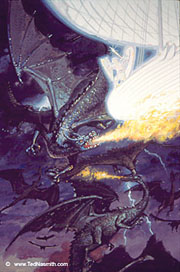
|
|
|
E�rendil and the
Eagles of Manw�
battling
Ancalagon the Black
and the
dragons of Morgoth
during the
War of Wrath.
The Valar answered the plea of the children of Il�vatar and finally destroyed the remnant of the servants of Morgoth, taking Morgoth himself captive. E�rendil himself led the battle along with the eagles of Manw�, personally killing Ancalagon the Black, the greatest of the dragons of Morgoth. Tolkien was probably inspired by the battle between Michael the archangel and the dragon Satan in
Revelation 12.
Image from
Tolkien Gateway.
|
Shortly after E�rendil's starry apotheosis, he was called into battle in
The War of Wrath,
declared by the Valar in response to E�rendil's plea to save Middle Earth from Morgoth's evil designs. E�rendil flew to the battle in the brilliant Vingil�t�, accompanied by all the birds of the sky, led by
Thorondor,
the King of the
Eagles of Manw�.
But he was met in the air by the mighty
Ancalagon the Black,
the greatest of the
dragons of Morgoth,
whom Morgoth had sent at the head of an army of flying
dragons
specifically to destroy E�rendil and Vingil�t� and to recapture the Silmaril. But E�rendil slew Ancalagon and cast him from the sky, his broken body falling onto Morgoth's fortress of
Thangorodrim
and destroying it. The Valar then rushed in and annihilated the remnant of the forces of Morgoth, even destroying all but a terrified few of the mighty Balrogs that had been the bane of many a valiant warrior, and once again chained Morgoth with Angainor, the great chain forged by Aul�, chaining it to his iron crown that they had now beaten into an iron collar.
The inspiration for the battle in the heavens between E�rendil and a dragon was probably inspired by the description of Michael the Archangel's defeat of the dragon in
Revelation 12:7-9
(cf. also
Daniel 12:1),
wherein the dragon is also cast down to Earth. This battle may also have been inspired by the Middle Kingdom Egyptian myth,
"The Repulsing of the Dragon and the Creation", wherein the Egyptian god
Ra
is seen destroying the dragon/serpent
Apophis,
who was the embodiment of darkness, death, and the void:
Apophis (Egyptian Apep) was the great adversary of the sun god, Re, and was the very embodiment of the powers of dissolution, darkness and non-being. Hence, he was a sort of void or "black hole" forcing those he swallowed into that non-existence which the Egyptians feared so greatly. Being completely outside of the natural world, he was believed to require no nourishment other than to "breathe" his own shouts. He was a huge serpent who was thought to have existed at the beginning of time in the waters of primeval chaos prior to creation and his power was so great that it was thought that he would continue to exist in an endlessly malevolent cycle of attack, defeat and resurgent attack. He is thus known by many epithets, ranging from evil lizard, opponent and enemy to world encircler and serpent of rebirth.43
Ra rode on his great sun boat, and in battle he used his mighty "Eye of Ra", a great jewel that sat on his head and shot out fire to destroy his enemies. E�rendil also rode in a boat, and also wore a great jewel on his head, the Silmaril that had been recovered by Beren and L�thien, which also gave him great power, though it was not specifically stated as to whether or not it "shot out fire". In either case, again the concept of wearing a powerful jewel on one's head in order to gain dominance over others is the dominant motif.

|
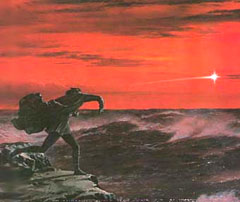
|
|
|
Maedhros
casting his Silmaril into the earth. Maglor and his brother
Maglor
were the only two remaining sons of Feanor. Seeing their chance, they stonle the Silmarilli from the Valar after they had conquered Morgoth, but their selfish and wicked motivations caused the Silmarilli to reject them, burning their hands so badly that the enraged brothers threw their jewels into the earth and the sea, respectively. Along with the third Silmaril that resided in the sky, in the care of E�rendil, the three great jewels found their intended home in the three natural elements: sky, earth and sea.
Image from
A Silmarillion Chronology.
|
|
Though one of the Silmarilli, perhaps the greatest of the three, was safe and accounted for in its new permanent setting, the other two remained in the hands of the Valar, cut from the crown of the captured Morgoth and held by E�nw�, the herald of the Valar, awaiting their next setting.
Maedhros
and
Maglor,
the two remaining brothers of the original seven sons of F�anor, realized that this was their last chance to reacquire the Silmarilli and fulfill their oaths to their father, so they stole into the camp and slew the guards, taking the remaining two Silmarilli and fleeing into the night. However, the Silmarilli did not accept their possession by the sons of F�anor as righteous due to their kinslaying and generally wicked intentions, so they burned their hands so badly that Maedhros, in a fit of pique, threw his Silmaril into a gaping chasm filled with fire, and Maglor threw his into the sea. As a result, the three Silmarilli found their homes in the three elements — air, earth and water.
And once again, there is a very interesting biblical cognate, once again in the Book of Revelation, this time in chapter 10:
I saw still another mighty angel coming down from heaven,
clothed with a cloud.
And a rainbow was on his head,
his face was like the sun,
and his feet like pillars of fire.
He had a little book open in his hand.
And he set his right foot on the sea
and his left foot on the land,
and cried with a loud voice,
as when a lion roars.
When he cried out,
seven thunders uttered their voices.
Now when the seven thunders uttered their voices,
I was about to write;
but I heard a voice from heaven saying to me,
"Seal up the things
which the seven thunders uttered,
and do not write them."
The angel whom I saw
standing on the sea
and on the land
raised up his hand to heaven
and swore by Him who lives forever and ever,
who created heaven and the things that are in it,
the earth and the things that are in it,
and the sea and the things that are in it,
that there should be delay no longer,
but in the days of the sounding of the seventh angel,
when he is about to sound,
the mystery of God would be finished,
as He declared to His servants
the prophets.
(Rev. 10:1-7, emphasis mine)
It would appear here that Tolkien enciphered the idea that heaven, earth and sea are associated with three great jewels as part of his interpretation of what he believed the secret was that the angel commanded John to "seal up" until the time of the end, an angel who also divided the universe into three divisions: heaven, earth, and sea. Interestingly, the angel's legs are described as "pillars of fire", perhaps the twin pillars Joachim and Boaz that sat at the entrance to the First Temple, which we saw previously were cognate to the two witnesses of Revelation 11, the chapter immediately after this one. So, chapter 10 of Revelation appears to be essentially a setup for chapter 11, which is a further exposition of the mystery of the three great jewels, chapter 10 focusing on the "master stone" of heaven (described as a "little book" held by the mighty angel), and chapter 11 focusing on the two jewels of earth and sea, the "twin jewels", or "Urim and Thummim", which are held by the two witnesses, and may be the keys to their mysterious powers.

|
|
|

|
|
|
In mythology, the
Gemini
(Latin for
"twins")
were twin brothers, variously believed to be either Castor and Pollux, Apollo and Hercules, and a variety of other pairings that varied from culture to culture. In every culture, however, they were either twins, or somehow a matched pair of "lights that are twins", which may be the true translation of the mysterious Urim and Thummim of the Bible. The top image shows the actual stars at the top left, a pair of nearly identical stars that are among the easiest to see in the heavens. The middle image show a classical rending of the twins, here shown as Hercules (left) and Apollo, though the biblical cognate would be Moses and Elijah. The bottom image shows the astrological sign for Gemini, which is a set of twin pillars that are actually one, the "twinning" motif being carried throughout, and easily correlating with our "two witnesses" motif discussed previously. The two witnesses are twin lights and twin pillars that stand before God, a riddle in which the constellation of Gemini and the mysterious Urim and Thummim may play a part. Interestingly, the English word "Gemini" has as its
root
the word "gem", as in "jewel", making the name of the constellation Gemini mean, literally, "the twin gems" or "the twin jewels". This goes back at least as far as Middle English ("coincidentally", one of Tolkien's specialties ;). Related Middle English words include such notables as gemelled ("paired, doubled"); gemelles, ("twins"); gemeue, ("a pair of hinges" (on which a door may swing, Christ being the door)); gemetrie, ("geometry/geomancy/freemasonry") and gemmarie ("jeweler"). So apparently Tolkien, the master linguist, made the connection between the constellation of Gemini and "twin jewels", as the word gemini literally means "two jewels".
Top image from
The Sirius Stargazers Club,
Middle image from
Philologos,
Bottom image from
Horoscoper.net.
|
|
|
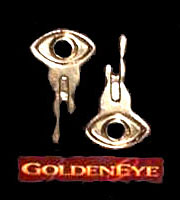
|
|
|
The gold keys from the James Bond film,
GoldenEye
(1995). In the film, the GoldenEye was a Russian-made nuclear-powered satellite that could destroy all electronics in a large area on Earth through the use of a powerful, directed
electromagnetic pulse.
In order to fire the weapon, however, two different operators with two different keys had to insert their special GoldenEye keys into two widely separated locks in order to enable the weapon, ensuring that one person could not do it alone to allow an additional measure of both security and accountability. These sort of measures are also taken with nuclear weapons and other very important, highly secure situations, so the idea that such a system would be in place for the Ark of the Covenant is completely plausible. Note that the keys are surmounted by eyes — could this be a not-so-subtle allusion to the "two (eye)witnesses", whose twin tsohar stones (the Urim and Thummim) may be the "keys" used to initiate the master stone on the Ark of the Covenant, whose powers may be similar to — or even greater than — the GoldenEye? Could there be a
007 Cypher?
|
It is interesting to note that the Silmarilli were a matched set of three, but it may be important to note that two of the Silmarilli also formed a pair that appeared to be lesser in stature than the third. Could Tolkien have been intimating that this was significant? It may be that the tsohar stones that Noah took with him on the ark were also a set of three jewels, but one was more important than the other two, which formed a pair unto themselves. It may be that the one "master stone" was the "book" held by the angel in Revelation 10, and the two other stones, one that was hidden in the earth, and the other that was hidden in the sea, were the keys to unlock that "book".
Along these lines, an interesting interpretation of the mysterious Urim and Thummim artifacts arises. Mentioned in
Exodus 28:30,
Leviticus 8:8,
Numbers 27:21,
and several other places in the Bible, the mysterious Urim and Thummim were used by the Hebrew high priest in an oracular function, where the priest was actually able to ask God specific questions and get specific answers. Traditionally, urim has been translated as "lights" (its most direct translation), and thummim has been translated as "perfections", in the sense of being whole, fulfilled, and/or giving additional details that complete one's understanding of a subject. This interpretation is based upon the Hebrew word tom (pronounced "tome"), which simply means "wholeness" or "completeness". Together, it may be that they indicate some sort of oracle that gives an answer to a question in two stages — the first oracle gives a general idea, and the second gives a more specific answer, like the hour hand on a clock is used to give the hour, and then the minute hand gives the minute, so that one can know the time to a fairly high degree of accuracy.
There has been much speculation as to what exactly the Urim and Thummim were, as they are long lost (or, more likely, hidden), along with the rest of the Temple furniture and accessories. Some speculate that they were actually a pair of large jewels that were worn on the breastplate of the high priest when he presented himself before God.44
Moreover, it is also possible that the word Thummim is actually based upon the nearly identical Hebrew word ta'am, "twins", indicating that the oracles are actually identical twin jewels that the high priest wore on each breast, shining forth with great light in answer to the priest's questions.45
If so, if Tolkien was aware of this fact, it may be why he set off two of the jewels as a "matched pair" that remained in the hands of the Valar until stolen and then lost by the sons of F�anor. It may be that two of the three tsohar stones ended up as the "Urim and Thummim", the "Lights that are Twins", twin jewels that were used by the high priest to communicate with God Himself.
Interestingly, the word Thummim may actually be the antecedent of the English word "tome" ("one of a series of large books"), indicating that perhaps these great jewels also contained a great deal of information embedded in their crystal matrices. A final interesting point is that word Urim begins with the first letter of the Hebrew alphabet, aleph (Greek alpha) and Thummim begins with the last letter of the Hebrew alphabet, tav (Greek, omega) respectively, which may be why Jesus referred to himself as the Alpha and the Omega, the Beginning and the End, the First and the Last
(Rev. 22:13)
— He, like the Urim and Thummim, possessed all knowledge. Or, it may be more accurate to say that Jesus holds the keys to all knowledge — i.e., he has the Urim and Thummim, or perhaps something even better, of which the Urim and Thummim were only types and shadows.
In sum, then, the Urim and Thummim were likely twin jewels that had enormous amounts of information embedded within them, which could also be used to communicate with God, assumedly in conjunction with a third, "master" stone that sat between the cherubim on the ark of the covenant. It could well be that these two stones do not actually contain the information, but are the "keys" that contain coded information needed to access the information inside the master stone. To use a computer metaphor, the "Urim and Thummim" could also be named "Username and Password" — a sign and a cosign designed to give authorized users access to a computer or website, and to keep unauthorized users out. However unlike a computer or website, approaching the ark without the necessary "keys" would mean that access to the information would not only be denied, but the would-be "hacker" would also be instantly killed by the ark. This might explain why Jesus says that He holds "the keys to Death and Hades" in Revelation 1:18 — only He can approach the heavenly ark in the heavenly temple to find the answers without being destroyed and cast into hell, just as the high priest could only safely approach the earthly ark in the earthly temple if he was wearing the "keys" — the "lights that are twins" the Urim and Thummim — twin tsohar stones that are needed to access the information in the master tsohar stone.
These stones may also be somehow related to the Two Witnesses in Tolkien's cipher because, in the end of time in the Middle Earth cosmogony, F�anor will be brought back from the dead, the Silmarilli will be returned to him, and he will break them open for Yavanna so that she can use their light to heal the Two Trees of Valinor. As such, Tolkien apparently believed that the key to understanding the prophecies of the end times may lie within three ancient precious stones — and if these stones could be "unsealed" or "broken open" (decoded) in order to reveal the ancient wisdom contained therein, the "two trees" — the "two witnesses" of Revelation 11 — would be "reborn". Could it be that these two "key stones" the Urim and Thummim, contain the keys to understanding "the two trees" — the two witnesses of Revelation 11 — who will be "reborn" in the end times?

|
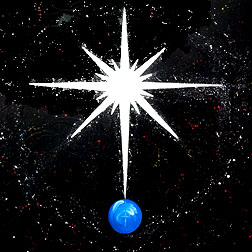
|
|
|
"The Bright Morning Star" by Barbara McCulloch. The
"bright and morning star" that Jesus described Himself as in
Revelation 22:16
may not be a star at all, but a previously undiscovered (or currently forgotten) planet in our solar system, a planet on which God Himself may dwell, a planet so far away that Moses needed a powerful transmitter/receiver such as the ark in order to communicate with Him. Cf. also
2 Peter 1:19,
Revelation 2:28
and
Malachi 4:2.
Just as the twin tsohar stones are apperently associated with the constellation of Gemini, it may be that the master stone is associated with this mysterious planet that Tolkien associated with the character E�rendil, a planet that would destroy the dragon and cast him down in the last battle
(Revelation 12; cf. also
Daniel 12.
Image from
Barbara McCulloch Fine Art.
|
|
Most important to the cipher, however, may be the understanding that perhaps one of the Silmarilli may have been more powerful than the other two "twin" Silmarilli. Whereas two of the Silmarilli were hidden in the earth and sea, out of sight and mind until the end of time when all things are restored, the third Silmaril was set in the heavens as a great star, the brightest star in the heavens. Earlier we conjectured that the third Silmaril was actually raised in relative importance to the other two because it was meant to represent the third and most important of the three tsohar stones that Noah carried with him from the world before the Great Flood. And whereas the two lesser "twin" stones ended up in the breastplate of the high priest as the Urim-Thummim, it may be that the third, "master" stone ended up being set in between the cherubim on the Ark of the Covenant itself, becoming known to history as the mysterious "Testimony" (aka the "lively oracle"), a great jewel set between the cherubim which Moses and the Aaronid priesthood used to literally see and speak to God face to face.
(Exodus 25:21-22;
Numbers 7:89;
Acts 7:37-38).
One commentator believes that the Urim and Thummim were actually what we would term today as "speakers", which emanated sound, so that the voice of God could be heard by the high priest.46
If so, the third, "master stone" may have been what we today would understand as a "television screen" that provided the visual component, so that Moses and the Aaronite priests could both see and hear God (and vice-versa).
This great jewel, that we conjecture was set in between the cherubim, also correlates nicely with the crystal "firestone" that Edgar Cayce spoke of in his visions, which was also used by the ancient Atlanteans to communicate with God. But why would Tolkien imply in his cipher that the third Silmaril was set on a heavenly "ship" that shone as a star in heaven, if it was actually set between the cherubim on the Ark of the Covenant? The answer may lie in another enigmatic passage in the Book of Revelation:
Then the temple of God was opened in heaven,
and the ark of His covenant was seen in His temple.
And there were lightnings, noises, thunderings, an earthquake,
and great hail.
(Rev. 11:19; cf. also
Rev. 15:5)
The tsohar "firestone" set in between the cherubim on the Ark of the Covenant was only one part of a two-way communications system. In other words, there was another firestone like it in heaven which was "tuned in" to the earthly stone (i.e., directly connected, possibly via
quantum coupling),
probably a much larger and much more powerful "chief firestone" that sits between the cherubim on the heavenly Ark in the Holy of Holies in the Heavenly Temple, the great Temple of which the earthly temple was but a type and a shadow.
|
|
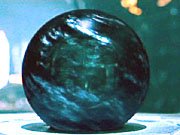
|
|
|
A
palant�r
is a sort of "crystal ball" used by wizards and kings in Tolkien's Middle Earth with which to communicate with each other, and to view objects and places from long distances. There were originally seven stones brought saved from the downfall of
N�menor
(Tolkien's cipher for
Atlantis)
by
King Elendil,
one of which, the
Osgiliath
stone, was a "master stone", larger than the others, which could be used to control the other six stones and to see everything that they saw.
Image from
Wikipedia.
|
A related part of the "stone cipher", as we saw previously, concerns the mysterious palant�ri. As we have seen, besides the Silmarilli, F�anor also created a series of stones called the palant�ri, which were essentially "crystal balls" that could be used to communicate with anyone who also possessed a palant�r over long distances in real time. It may be that through his cipher Tolkien split up the concept of the multi-purpose tsohar firestones into different types of jewels in order to elaborate on the various functions of the firestones, which apparently included both communication (the palant�ri), healing (the Ellesar), and destruction (the Silmarilli, which were apparently used as a weapon by E�rendil in The War of Wrath).47
More to the point, Tolkien's description of the palant�ri was that one of the stones,
"The Stone of Osgiliath"
was a "master stone", a larger and more powerful palant�r that could be used to control the other seeing stones.48
This concept of a "master stone" may be what Tolkien was trying to communicate when he spoke of the heavenly Silmaril: the chief and most powerful firestone of the three that sits between the cherubim on the earthly Ark of the Covenant is connected to an even more powerful "chief firestone" that is in heaven, in between the cherubim on the heavenly Ark of the Covenant. This is the secret of the Silmaril stone cipher — that the Urim-Thummim were two twin firestones that were smaller than the third, "master stone" that sat in between the cherubim on the mercy seat of the earthly Ark of the Covenant, which was in turn connected to a much larger "chief" master firestone that sat between the cherubim in the much larger and much more important heavenly Ark of the Covenant, that resides in the heavenly Temple. In effect, there is a "hierarchy of firestones", where the one who controls the largest stone controls all the rest.
This "chief cornerstone"
(Matthew 21:42-44, cf. also
Psalm 118:22-23;
Zechariah 4:7-10
Revelation 11:19
)
is directly controlled by God Himself, which he uses to survey the Earth in general and, when the Ark was functional, communicate with Moses and the Aaronite priesthood face to face.49 It is this same "chief cornerstone" that will be the primary weapon that God will use to destroy the final beast kingdom
(Daniel 2:31-35; Zechariah 4:7; Revelation 18:21; Revelation 19:21; Revelation 11:19). Just as the earthly ark could be used as a weapon, so too can the heavenly ark.
But how does a "star" figure into this equation? It stands to reason that God's Temple in heaven must have a platform on which to sit, a platform that apparently moves. And the only kind of object in space that could fit the profile of a large, moving "platform" in space is a planet. And since Venus — which Tolkien apparently believed was the location of the heavenly firestone — is a well-known planet and clearly uninhabitable, could it be that God's temple is located on another planet in our solar system, a planet that is now hidden to us? Is the mysterious "star of E�rendil", about which Tolkien darkly hinted, actually be a mysterious "tenth planet" in our solar system, where the most powerful firestone of all is kept, hidden away until the final battle?

|
After E�rendil slew and threw down Ancalagon the Black, the greatest of the dragons of Morgoth, with the power of the Silmaril, most of the remaining dragons were slain by Manw�'s eagles (cf.
Matt. 24:26-28,
Rev. 19:17-21),
only a handful escaping to fight another day. So too were all but a few of the mighty Balrogs slain, cast down and buried deep under the Earth when
Thangorodrim,
Morgoth's last great fortress, was broken by the fall of Ancalagon and obliterated by the rage of the Valar. Finally, Morgoth was captured once again, but this time there was no mercy. Having proven beyond a shadow that he was corrupt beyond redemption, he was taken to the pillars of night and cast out into the Void:
But Morgoth himself the Valar thrust through the Door of Night beyond the Walls of the World, into the Timeless Void; and a guard is set for ever on those walls, and E�rendil keeps watch upon the ramparts of the sky. Yet the lies that Melkor, the mighty and accursed, Morgoth Bauglir, the Power of Terror and of Hate, sowed in the hearts of Elves and Men are a seed that does not die and cannot be destroyed; and ever and anon it sprouts anew, and will bear dark fruit even unto the latest days.50
This once again is clearly a reference to the fallen angels being cast down into hell, chained in pits of darkness until the end of time, as described in the second epistle of Peter:
God did not spare the angels who sinned,
but cast them down to hell and delivered them into chains of darkness,
to be reserved for judgment;
and did not spare the ancient world,
but saved Noah, one of eight people,
a preacher of righteousness,
bringing in the flood on the world of the ungodly.
(2 Peter 2:4-5)
Jude also talks at length about how the fallen angels who rebelled were cast into "pits of darkness":
But I want to remind you,
though you once knew this,
that the Lord, having saved the people out of the land of Egypt,
afterward destroyed those who did not believe.
And the angels who did not keep their proper domain,
but left their own abode,
He has reserved in everlasting chains under darkness
for the judgment of the great day.
(Jude 1:5-6)
And of course Satan himself is cast into a "bottomless pit" for 1,000 years:
Then I saw an angel coming down from heaven,
having the key to the bottomless pit and a great chain in his hand.
He laid hold of the dragon,
that serpent of old,
who is the Devil and Satan,
and bound him for a thousand years;
and he cast him into the bottomless pit,
and shut him up,
and set a seal on him,
so that he should deceive the nations no more
till the thousand years were finished.
But after these things he must be released for a little while.
(Rev. 20:1-3)

|
Like Satan and the other fallen angels, Morgoth will break out of his prison behind the pillars of night in the last days, and resurrect many of his old followers in a last desperate battle for control of Middle Earth. However, whereas
The War of Wrath
was clearly modeled on the battle of Armageddon, as described in
Revelation 19:11-21,
the
Dagor Dagorath
(lit., "Final Battle") is clearly based upon the true last battle between God and Satan as described in
Revelation 20:7-10,
where Satan, after having been released from his 1,000-year prison, makes one more desperate attempt to challenge God for the sovereignty of the universe. Like Satan, however, Morgoth is then finally destroyed, the power of evil finally conquered.
According to the prophecy, included in
The Shaping of Middle-Earth
and in
The Lost Road
in an almost identical version Morgoth will discover how to break the Door of Night, and will destroy the Sun and the Moon. For the love of these, E�rendil will return from the sky and shall meet Tulkas, E�nw� with the old version of his name Fionw�, and T�rin Turambar on the plains of Valinor. All the Free Peoples of Middle-earth will participate in this final battle, Elves, Men and Dwarves alike. There the forces of the Valar shall fight against Melkor, who will have resurrected many of his old followers, including Sauron. Tulkas will wrestle with him, but it will be by the hand of T�rin that finally death and destruction will be dealt to Melkor. T�rin will run his black sword Gurthang (Iron of Death) through Melkor's heart, thus avenging the Children of H�rin (Sindarin: Ch�n H�rin) and all Men. Then the Pel�ri Mountains will be leveled, the three Silmarils will be recovered from the Earth, sea, and sky, and F�anor's spirit shall be released from the halls of Mandos to give them to Yavanna, who will break them and rekindle the light of the Two Trees. The battle will end and renew Arda's existence: all the Elves shall awake and the Powers will be young again. Also, according to Dwarven legends, they will help their maker Aul� recreate Arda in all its glory again. Following this, there will be a Second Music of the Ainur. This song will sing into being a new world. Men will sing it with the Ainur. It is unknown what the fate of the old races, or of the old world, will be in the new one. Even the Ainur do not know anything of the second world or the Second Music. All the Ainur know is that the Second Music will be greater than the First Music.51

|
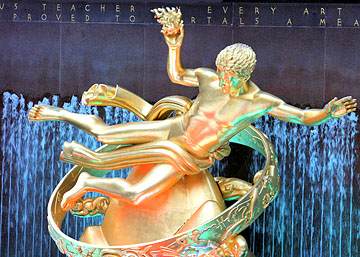
|
|
|
Paul Manship's
famous statue of Prometheus at the center of the also famous
Rockefeller Center
in New York City, shown carrying fire to give to mankind while astride a golden ring that encircles the Caucasus Mountains. The inscription behind it reads,
Prometheus, teacher in every art, brought the fire that hath proved to mortals a means to mighty ends.
One wonders why the
Rockefellers
chose this particular character to be displayed at the center of the largest, wealthiest and arguably most important city in the world.
Image from
Wikipedia.
|
|
Though the story in the Bible ends with the final defeat of Satan, the story in The Silmarillion does not end with the defeat of Morgoth. Tolkien instead stretches out the story, elevating Morgoth's chief lieutenant,
Sauron,
to "play the Satan" of Middle Earth, which he does ably in both The Hobbit and The Lord of the Rings, Morgoth not coming to his final end until much later.
Whereas Morgoth was clearly modeled on the figure of Satan, Sauron was clearly modeled after Prometheus, whose power was inextricably linked to his "magic ring", which he was forced to wear by Zeus for all eternity. Like the biblical
Nimrod,
Sauron was a lesser but still very powerful being who attempted to recreate the power of evil in the world after the Flood that had destroyed the works of his predecessors.
Possibly the reason that Tolkien created the figure of Sauron was because, in his cipher, he needed an antichrist figure — not Satan per se, but one who was filled with the spirit of Satan, his master. However, unlike Sauron, it may be the antichrist will also be searching for the lost jewels which, as we have seen, control of which may determine who controls the destiny of the world.
It may also be that Tolkien foresaw the time that mankind would become totally evil and, like Nimrod of old, build a tall tower with which to unite mankind. However, though freedom may be the ostensible purpose of this tower, the end thereof may be the same tower of tyranny, and at the top, the same great red eye.
Introduction
|
J.R.R. Tolkien
|
The Song of Creation
|
The Shaping of Earth
Two Lamps, Two Trees, Two Witnesses
|
The War of the Jewels
|
Morgoth's Ring
LOTR_Cipher Notes
|
LOTR_Cipher Links
|
LOTR_Cipher Books
|
LOTR_Cipher Audio
LOTR_Cipher Video
|
LOTR_Cipher Collectibles
Editorial
|
Press Releases
|
Book Reviews
|
Fragments
Artifacts: The Exodus Revelation I
The Journey: Ireland I
|
Giants of Ireland
|
The Lord of the Rings Cipher I
Register
for our Hall of Records Newsletter
Questions? Comments? Suggestions? Advertising? Press Releases?
Contact us!

1
Ethan Gilsdorf,
"J.R.R. Tolkien and C. S. Lewis: A Literary Friendship and Rivalry"
(Literary Traveler: http://www.literarytraveler.com).
2
Wikipedia,
"Robert E. Howard"
(Wikipedia: http://en.wikipedia.org).
Howard, whom some feel was a great inspiration to Tolkien, created an entire world that he theorized actually existed "between the time when the oceans drank
Atlantis,
and the rise of
the sons of Aryas",
which he called the Hyborean Age. Though it was fairly well fleshed out, it lacked the subtle details such as non-human races and multiple languages that Tolkien actually created almost ex nihilo. Lovecraft and Moorcock also created their own universes in which their heroes fought and strove to make their mark, but Moorcock's characters, such as the classic Elric of Melnibon�, were actually drawn purposely as anti-heroes specifically in order to contrast the writings of Tolkien and Howard.
3
Tom Shippey,
J.R.R. Tolkien: Author of the Century
(New York: Houghton Mifflin, 2000).
4
Humphrey Carpenter,
J.R.R. Tolkien: A Biography
(New York: Houghton Mifflin, 2000), 28-29.
5
J.R.R. Tolkien,
The Silmarillion
(New York: Houghton Mifflin, 2001), 87.
6
Carpenter,
Biography, 67, 97-98.
7
Carpenter,
Biography, 101.
8
Carpenter,
Biography, 83.
9
Bradley J. Birzer,
J. R. R. Tolkien's Sanctifying Myth: Understanding Middle-Earth (Wilmington, DE: ISI Books, 2002), 23-24.
10
Carpenter,
Biography, 99-101.
11
J. R. R. Tolkien, Christopher Tolkien ed.,
The Letters of J.R.R. Tolkien (New York: Houghton Mifflin, 1995), 144-145.
12
Carpenter,
Biography, 99.
13
Tolkien,
The Silmarillion, 3-4.
14
One of the reasons Tolkien had F�anor the elf (q.v.) create three jewels may have been that he wanted them to symbolize the Holy Trinity — a God who was three, yet one.
15
Tolkien,
The Silmarillion, 4-5. Note that Melkor was the fifteenth and greatest of the Valar, but was removed from their ranks after falling from heaven.
16
Tolkien,
The Silmarillion, 6-7.
17
Text adapted from Ellie Crystal, "Ayer's Rock, Uluru" (Crystalinks: http://www.crystalinks.com/ayersrock.html). Cf. also
http://www.mysteriousworld.com/Journal/2002/Autumn/Atlantis/#TheOriginsOfMan.
18
Tolkien,
The Silmarillion, 10-12.
19
Tolkien,
The Silmarillion, 27-28.
20
Tolkien,
The Silmarillion, 31.
21
Wikipedia,
"F�anor"
(Wikipedia: http://en.wikipedia.org).
22
Wikipedia,
"F�anor".
23
Carpenter,
J.R.R. Tolkien: A Biography, 67, 101.
24
Carpenter,
J.R.R. Tolkien: A Biography, 101.
25
Silima may be based upon the Greek word
thelema,
"will", which
Aleister Crowley
used at length in his profane occult treatises. It was also used in the Bible to describe the "will" of God, so its function is not strictly negative in orientation. Tolkien probably intended to focus on the concept that F�anor "willed" the jewels into existence, that they were a product of his and his alone. It is also interesting to note that at the heart of Buddism is the principle of
"The Three Jewels"
that Buddhists look to for guidance. Could this concept actually be the memory of three actual ancient jewels which had mysterious powers? Furthermore, could these three jewels have also been one of Tolkien's inspirations for the three Silmarilli?)
26
Rabbi Geoffrey W. Dennis,
"Tzohar" (Encyclopedia Mythica: http://www.pantheon.org/articles/t/tzohar.html).
27
Anonymous,
"The Tsohar" (Encyclopedia Mythica: http://www.indyfan.com/ark/tsohar.html).
28
See
"The Exodus Revelation"
previously in this issue for an in-depth discussion of the tsohar "firestones" and how they have played crucial roles throughout the history of mankind. It is interesting to note that the term "three jewels" is used frequently in
Masonic initiations,
as well as
Buddhist
teachings.
29
J. F. Sutton,
"The Atlantean Tuaoi Stone Revisited" (The Hutton Commentaries: http://www.huttoncommentaries.com/subs/Special/AtlanRec_Firestone/Tuaoi/ TuaoiRevisited.htm), edited for brevity. Note that Cayce's reference to "the entity" refers to his belief that he was able to communicate with spirit entities who had reincarnated themselves over and over again throughout history, even from the beginning of human history, so Cayce allegedly was able to find out about the past by questioning the spirit of the person asking for the "reading" where he or she was and what they were doing in the past. This was how he was allegedly able to find out so much about Atlantis — so many "entities" who had once lived in Atlantis reincarnated in the 20th century that Cayce was able to relate an enormous amount of information about that period of Earth's history.
30
For more information on the mysterious firestones in the Bible, see
"The Exodus Revelation" elsewhere in this issue.
31
Association for Research and Enlightenment A.R.E. �, Inc.,
"Searching for the Hall of Records in the Yucatan" (Edgar Cayce's A.R.E.: http://www.edgarcayce.org/about_ec/cayce_on/ancient/search.html)
32
Geoffrey W Burr,
"Optical data storage enters a new dimension" (PhysicsWorld.com: http://physicsweb.org/articles/world/13/7/7);
see also
http://www.research.ibm.com/journal/rd/443/ashley.html;
http://en.wikipedia.org/wiki/3D_optical_data_storage;
http://en.wikipedia.org/wiki/Crystal;
http://en.wikipedia.org/wiki/Hologram;
http://en.wikipedia.org/wiki/Computer_storage#Optical_storage;
http://en.wikipedia.org/wiki/Holographic_Versatile_Disc.
33
See
http://www.t1shopper.com/tools/calculate/
for a conversion calculator to see how large a Petabyte is.
34
"Native American Legends: The Spider Woman and The Twins" (First People: http://www.firstpeople.us/FP-Html-Legends/TheSpiderWomanandtheTwins-Hopi.html).
Interestingly, in the Hopi myth of Spider Woman, the first thing she created were two twin males, P�q�nghoya and Pal�ngawhoya, which may be the Hopi version of the "two witnesses" concept discussed previously. Tolkien appears to have found some very deep correlaries in mythology, as far afield as the Desert Southwest of America. An important point to note is that Spider Woman brought life to the twins, and all plants and animals, through the use of something called a "white substance cape", which was "the creative wisdom itself". Could this be the same substance as the heavenly manna mentioned in the Bible? See
"Exodus Revelation"
for more on this critical subject.
35
Tolkien-Online.com,
"Morgoth's Ring" (Tolkien-Online.com: http://www.tolkien-online.com/morgoths-ring.html).
36
Carpenter,
J.R.R. Tolkien: A Biography, 101.
37
"Iron Crown of Lombardy" (Wikipedia: http://en.wikipedia.org/wiki/Iron_Crown_of_Lombardy).
38
"Lombards" (Wikipedia: http://en.wikipedia.org/wiki/Lombards). Cf. also
"Lombardy" (Wikipedia: http://en.wikipedia.org/wiki/Lombardy)
39
"Iron Crown of Lombardy" (Wikipedia: http://en.wikipedia.org/wiki/Iron_Crown_of_Lombardy). Cf. also
"Order of the Iron Crown" (Wikipedia: http://en.wikipedia.org/wiki/Order_of_the_Iron_Crown) and
"Charlemagne's "Iron Crown"" (Order of the Crown of Charlemagne in the United States of America: http://www.charlemagne.org/ic.html).
Charlemagne's father was named "Pippin the Short", probably where Tolkien took the name for the Hobbit "Pippin" in The Lord of the Rings. Theodolinda, the Queen of the Lombards, Germanic conquerors of northern Italy, was said to have found the crown. Was she the inspiration for Theoden of Rohan, or perhaps for Eowyn, who reigned after his death, or perhaps a combination of both?
(http://en.wikipedia.org/wiki/Theodelinda)
40
Carpenter,
J.R.R. Tolkien: A Biography, 72.
41
Carpenter,
J.R.R. Tolkien: A Biography, 72, 79, 83.
42
"E�rendil" (Wikipedia: http://en.wikipedia.org/wiki/Earendel).
43
Jimmy Dunn,
"Apophis (Apep), the Enemy of Re" (Wikipedia: http://touregypt.net/featurestories/apep.htm).
44
"Urim and Thummim" (Wikipedia: http://en.wikipedia.org/wiki/Urim_and_Thummim). Interestingly, the Mormons believed that their founder, Joseph Smith, had been led by an angel to find a cache of golden plates that could only be read with what the angel called "Urim and Thummim", which Smith described as essentially a pair of silver-rimmed glasses with smooth, three-cornered diamonds for lenses. Whereas this cannot be corroborated, the idea that the Urim and Thummim were essentially a pair of glasses that could be used to decipher encoded text is a very plausible one. Click here to read more about this fascinating theory.
45
"Urim and Thummim" (Jewish Encyclopedia: http://www.jewishencyclopedia.com/view.jsp?artid=52&letter=U).
46
"Oracles of God — The Urim and Thummim" (Israel Elect of Zion: http://www.israelect.com/reference/WesleyASwift/sermons/68-11-06.htm). Note that the author appears to be a racist, so take his teachings with a large grain of salt.
47
See
"The Exodus Revelation"
previously in this issue for an in-depth discussion of the tsohar "firestones".
48
"The Palant�ri: The Stone of Osgiliath" (The Thain's Book: http://www.tuckborough.net/palantir.html#Osgiliath Stone). See also http://en.wikipedia.org/wiki/Palant%C3%ADr.
49
The seven palantiri "seeing stones" may correspond to seven mobile firestones that God uses to routinely survey the Earth and "keep an eye on things"
(Zech. 4:10).
One of these "eyes of the Lord" vehicles, each of which appear to be essentially a huge firestone on a square platform driven by a combination of four turbine engines ("wheels within wheels") on each corner, with
suction
to reduce drag (the word ayin, in Hebrew, incorrectly translated as "eyes" here, basically means "holes"), appeared in a vision to Ezekiel in
Ezekiel 1.
Basically, it appears that God sits on His heavenly throne and looks into the chief firestone on the heavenly Ark, which is hooked up to the seven mobile firestones, that transmit images back to Him so he can constantly survey the entire planet, just as the Kings of Gondor once used The Stone of Osgiliath in Tolkien's cipher.
50
Tolkien,
Silmarillion, 306.
51
"Dagor Dagorath" (Wikipedia: http://en.wikipedia.org/wiki/Dagor_Dagorath).
Selected Lord of the Rings-oriented content © The J.R.R. Tolkien Estate Ltd., EA Games or New Line Cinema, and is used for didactic purposes only. The terms "Lord of the Rings Cipher", "LOTR Cipher" and all original concepts and content are all © 2007 Doug Elwell, Inc. All Rights Reserved. All Bible quotations are taken from the New Kings James Version (NKJV) unless otherwise noted.




 The Tolkien Society
The Tolkien Society
 TheOneRing.net
TheOneRing.net
 TheOneRing.net: Peter Jackson and New Line Cinema Join with MGM to Produce "The Hobbit" Movie
TheOneRing.net: Peter Jackson and New Line Cinema Join with MGM to Produce "The Hobbit" Movie
 LordOfTheRings.net: The Official Movie Site
LordOfTheRings.net: The Official Movie Site
 The Hobbit: The Official Movie Blog
The Hobbit: The Official Movie Blog
 Watchman Fellowship: Tolkien, Fantasy and Magic
Watchman Fellowship: Tolkien, Fantasy and Magic
 The Lost Tolkien Novel
The Lost Tolkien Novel
 Internet Sacred Text Archive: Sources of Lord of the Rings
Internet Sacred Text Archive: Sources of Lord of the Rings
 The Elvish Linguistic Fellowship: Resources for Tolkienian Linguistics
The Elvish Linguistic Fellowship: Resources for Tolkienian Linguistics
 Ted Nasmith: The J.R.R. Tolkien Gallery
Ted Nasmith: The J.R.R. Tolkien Gallery
 Arwen-Undomiel.com
Arwen-Undomiel.com
T R A V E L:
Bloemfontein, South Africa (Tolkien's Birthplace)
 Southern Africa Places: Bloemfontein
Southern Africa Places: Bloemfontein
 Mangaung Local Municipality: Bloemfontein - Botshabelo - Thaba Nchu
Mangaung Local Municipality: Bloemfontein - Botshabelo - Thaba Nchu
 SouthAfrica.net: Bloemfontein — Heart of the Free State
SouthAfrica.net: Bloemfontein — Heart of the Free State
 SafariNow.com: Bloemfontein
SafariNow.com: Bloemfontein
 Wikipedia: Bloemfontein
Wikipedia: Bloemfontein
 Wikitravel: Bloemfontein
Wikitravel: Bloemfontein
 Wikipedia: Orange Free State
Wikipedia: Orange Free State
 Wikipedia: South Africa
Wikipedia: South Africa
Birmingham, England (Tolkien's Childhood Years)
 Wikipedia: Birmingham, England
Wikipedia: Birmingham, England
 Birmingham City Council
Birmingham City Council
 Birmingham City Council: The Shire Country Park: Tolkien Weekend
Birmingham City Council: The Shire Country Park: Tolkien Weekend
 Visit Birmingham
Visit Birmingham
 Britain Express: West Midlands
Britain Express: West Midlands
 Wikipedia: West Midlands
Wikipedia: West Midlands
 Warwickshire County Council
Warwickshire County Council
 Heart-of-England: Best Tourist Attractions in the Heart of England
Heart-of-England: Best Tourist Attractions in the Heart of England
 Heart-of-England: Village of Sarehole
Heart-of-England: Village of Sarehole
 Heart-of-England: Dormston with Bag End
Heart-of-England: Dormston with Bag End
 Heart-of-England: Tolkien's Warwickshire
Heart-of-England: Tolkien's Warwickshire
 Wikipedia: Sarehole
Wikipedia: Sarehole
 Wikipedia: Sarehole Mill
Wikipedia: Sarehole Mill
 Birmingham Picture Library: Sarehole
Birmingham Picture Library: Sarehole
 Birmingham City Council: Sarehole Mill (w/map)
Birmingham City Council: Sarehole Mill (w/map)
 Birmingham City Council: The Shire Country Park
Birmingham City Council: The Shire Country Park
 Birmingham City Council: The Shire Country Park: Tolkien Weekend
Birmingham City Council: The Shire Country Park: Tolkien Weekend
 Birmingham City Council: Moseley Bog Local Nature Reserve
Birmingham City Council: Moseley Bog Local Nature Reserve
 Shire Productions: Outdoor Theatre and Dramatisations of J.R.R Tolkien's Works
Shire Productions: Outdoor Theatre and Dramatisations of J.R.R Tolkien's Works
 The Tolkien Society: Sarehole
The Tolkien Society: Sarehole
 Virtual Brum: Tolkien's Birmingham (pictures)
Virtual Brum: Tolkien's Birmingham (pictures)
 Tolkien Gateway: Sarehole
Tolkien Gateway: Sarehole
 Tolkien Gateway: Sarehole Mill
Tolkien Gateway: Sarehole Mill
 Wikipedia: Edgebaston
Wikipedia: Edgebaston
 Birminghamuk.com: Voice of the West Midlands
Birminghamuk.com: Voice of the West Midlands
 Birminghamuk.com: Edgebaston Tourist Information
Birminghamuk.com: Edgebaston Tourist Information
 Birminghamuk.com: Photographs of Edgbaston Birmingham
Birminghamuk.com: Photographs of Edgbaston Birmingham
 Birmingham Oratory
Birmingham Oratory
 The Birmingham Oratory: Tolkien and the Oratory
The Birmingham Oratory: Tolkien and the Oratory
Tours (Including Locations for the Films)
 TheOneRing.net: Middle-Earth Tours
TheOneRing.net: Middle-Earth Tours
 NewZealand.com: Lord of the Rings Tours
NewZealand.com: Lord of the Rings Tours
 New Zealand Tourism Online: Lord of the Rings Tours
New Zealand Tourism Online: Lord of the Rings Tours
 The Misty Mountains (Australia)
The Misty Mountains (Australia)


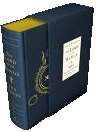 The Lord of the Rings (50th Anniversary Edition)
The Lord of the Rings (50th Anniversary Edition)
J. R. R. Tolkien
Rating:     
The Fellowship of the Ring, part one of J.R.R. Tolkien�s epic masterpiece, fist reached these shores on October 21, 1954, arriving, as C. S. Lewis proclaimed, "like lightning from a clear sky." Fifty years and nearly one hundred million American readers later comes a beautiful new one-volume collector�s edition befitting the stature of this crown jewel of our list. With a text fully corrected under the supervision of Christopher Tolkien to meet the author�s exacting wishes, two large-format fold-out maps, a ribbon placemarker, gilded page edges, a color insert depicting Tolkien's own paintings of the Book of Mazarbul and exceptionally elegant and sturdy overall packaging housed within an attractive slipcase, this edition is the finest we�ve ever produced.
Click
here
to buy this book.
 The Silmarillion
The Silmarillion
J. R. R. Tolkien
Rating:     
The Silmarillion is J.R.R. Tolkien's tragic, operatic history of the First Age of Middle-Earth, essential background material for serious readers of the classic Lord of the Rings saga. Tolkien's work sets the standard for fantasy, and this version of the "Bible of Middle-Earth" does The Silmarillion justice, conveying all the powerful events and emotions that shaped elven and human history long before Bilbo, Frodo, Gandalf and all the rest embarked on their quests. Beginning with the Music of the Ainur, The Silmarillion tells a tale of the Elder Days, when Elves and Men became estranged by the Dark Lord Morgoth's lust for the Silmarils, pure and powerful magic jewels. Even the love between a human warrior and the daughter of the Elven king cannot defeat Morgoth, but the War of Wrath finally brings down the Dark Lord. Peace reigns until the evil Sauron recovers the Rings of Power and sets the stage for the events told in the Lord of the Rings. This is epic fantasy at its finest, thrillingly and gloriously unabridged.
Click
here
to buy this book.
 Morgoth's Ring: The Later Silmarillion, Part One
Morgoth's Ring: The Later Silmarillion, Part One
(The History of Middle-Earth, Vol. 10)
J. R. R. Tolkien, Christopher Tolkien, ed.
Rating:     
In Morgoth's Ring, the tenth volume of The History of Middle Earth and the first of two companion volumes, Christopher Tolkien describes and documents the legends of the Elder Days, as they were evolved and transformed by his father in the years before he completed The Lord of the Rings. The text of the "Annals of Aman", the "Blessed Land" in the far West, is given in full. And in writings never before published, we can see the nature of the problems that J.R.R. Tolkien explored in his later years as new and radical ideas, portending upheaval in the heart of the mythology. At this time Tokien sought to redefine the old legends, and wrote of the nature and destiny of Elves, the idea of Elvish rebirth, the origins of the Orcs, and the Fall of Men. His meditation of mortality and immortality as represented in the lives of Men and Elves led to another major writing at this time, the "Debate of Finrod and Andreth," which is reproduced here in full. "Above all," Christopher Tolkien writes in his foreword, "the power and significance of Melkor-Morgoth...was enlarged to become the ground and source of the corruption of Arda." This book indeed is all about Morgoth. Incomparably greater than the power of Sauron, concentrated in the One Ring, Morgoth's power (Tolkien wrote) was dispersed into the very matter of Arda: "The whole of Middle-earth was Morgoth's Ring." (From the book description)
Click
here
to buy this book.
 The War of the Jewels: The Later Silmarillion, Part Two
The War of the Jewels: The Later Silmarillion, Part Two
(The History of Middle-Earth, Vol. 11)
J. R. R. Tolkien, Christopher Tolkien, ed.
Rating:     
In volumes ten and eleven of The History of Middle-earth, Christopher Tolkien recounts from the original texts the evolution of his father's work on The Silmarillion, the legendary history of the Elder Days or First Age, from the completion of The Lord of the Rings in 1949 until J.R.R. Tolkien's death. In volume ten, Morgoth's Ring, the narrative was taken only as far as the natural dividing point in the work, when Morgoth destroyed the Trees of Light and fled from Valinor bearing the stolen Silmarils. In The War of the Jewels, the story returns to Middle-earth and the ruinous conflict of the High Elves and the Men who were their allies with the power of the Dark Lord. With the publication in this book of all of J.R.R. Tolkien's later narrative writing concerned with the last centuries of the First Age, the long history of The Silmarillion, from its beginnings in The Book of Lost Tales, is completed; the enigmatic state of the work at his death can now be understood. A chief element in The War of the Jewels is a major story of Middle Earth, now published for the first time — a continuation of the great "saga" of Turin Turambar and his sister Nienor, the children of Hurin the Steadfast. This is the tale of the disaster that overtook the forest people of Brethil when Hurin came among them after his release from long years of captivity in Angband, the fortress of Morgoth. The uncompleted text of the Grey Annals, the primary record of The War of the Jewels, is given in full; the geography of Beleriand is studied in detail, with redrawings of the final state of the map; and a long essay on the names and relations of all the peoples of Middle Earth shows more clearly than any writing yet published the close connection between the language and history in Tolkien's world. The text also provides new information, including some knowledge of the divine powers, the Valar. (From the book description)
Click
here
to buy this book.
 The Shaping of Middle-Earth: The Quenta, the Ambarkanta and the Annals
(The History of Middle-Earth, Vol. 4)
The Shaping of Middle-Earth: The Quenta, the Ambarkanta and the Annals
(The History of Middle-Earth, Vol. 4)
J. R. R. Tolkien, Christopher Tolkien, ed.
Rating:     
This is the fourth volume of The History of Middle-earth, edited by Christopher Tolkien, the first two comprising The Book of Lost Tales Parts One and Two, and the third The Lays of Beleriand.
It has been given the title The Shaping of Middle Earth because the writings it includes display a great advance in the chronological and geographical structure of the legends of Middle Earth and Valinor. The hitherto wholly unknown Ambarkanta, or "Shape of the World", is the only account ever given of the nature of the imagined universe, and it is accompanied by diagrams and maps of the world before and after the cataclysms of the War of the Gods and the Downfall of Numenor. The first map of Beleriand, in the North-west of Middle-earth, is also reproduced and discussed. In the "Annals of Valinor" and the "Annals of Beleriand" the chronology of the First Age is given shape; and with these are given the fragments of the translations into Anglo-Saxon made by Aelfwine, the Englishman who voyaged into the True West and came to Tol Eressea, the Lonely Isle, where he learned the ancient history of Elves and Men.
Also included are the original "Silmarillion," written in 1926, from which all the later development proceeded, and the "Quenta Noldorinwa" of 1930, the only version of the myths and legends of the First Age that J.R.R. Tolkien completed to their end. As Christopher Tolkien continues editing the unpublished papers that form the bedrock from which The Lord of the Rings and The Silmarillion were quarried, the vastness of his father's accomplishment becomes even more extraordinary. (From the book description)
Click
here
to buy this book.
 J.R.R. Tolkien: A Biography J.R.R. Tolkien: A Biography
Humphrey Carpenter
Rating:    
Though he single-handedly gave a mythology to the English and was beloved by millions, John Ronald Reuel Tolkien remained refreshingly unchanged by his fame and fortune, living out his days simply and modestly among the familiar surroundings of Oxford College. Humphrey Carpenter, who was given unrestricted access to Tolkien's papers, brilliantly puts meat to the bones of the Tolkien legend in J.R.R. Tolkien: A Biography, offering a well-rounded portrayal of this quiet, bookish man who always saw himself first and foremost as a philologist, uncovering rather than creating the peoples, languages, and adventures of Middle-Earth.
Carpenter chronicles Tolkien's early life with a special sensitivity; after losing both parents, Tolkien and his brother Hilary were taken from their idyllic life in the English countryside to a poverty-ridden existence in dark and sooty Birmingham. There were bright points, however. A social and cheerful lad, Tolkien enjoyed rugby and was proud of his gift for languages. It was also at this time that he met Edith Bratt, who would later become his wife. Academic life — both as a student and professor — is where this biography shines. Friendship with other men played a huge part in Tolkien's life, and Carpenter deftly reveals the importance these relationships — his complex friendship with C.S. Lewis, membership in the Inklings and the T.C.B.S. — had on the development of his writing. (Review by Amazon.com)
Click
here
to buy this book.
 The Letters of J.R.R. Tolkien
The Letters of J.R.R. Tolkien
J. R. R. Tolkien, Christopher Tolkien ed.
Rating:    
Scholars and fans of the great mythologist will find a rich vein of information in Humphrey Carpenter's The Letters of J.R.R. Tolkien. Tolkien was a prodigious letter writer all his life; the sheer mass of his correspondence would give pause to even the most stalwart archivist (one shudders to think what he would have done with e-mail). But with the able assistance of Tolkien's son Christopher and a healthy dose of determination, Carpenter manages find the cream of the crop--the letters that shed light on Tolkien's thoughts about his academic and literary work, as well as those that show his more private side, revealing a loving husband, a playful friend, and a doting father. The most fascinating letters are, of course, those in which he discusses Middle-Earth, and Carpenter offers plenty of those to choose from. Tolkien discussed the minutia of his legend--sometimes at great length--with friends, publishers, and even fans who wrote to him with questions. These letters offer significant insights into how he went about creating the peoples and languages of Middle-Earth.
This new edition of letters has an extensive index, and Carpenter has included a brief blurb at the beginning of each letter to explain who the correspondent was and what was being discussed. Still, we strongly recommend buying the companion volume,
J.R.R. Tolkien: A Biography,
in order to better understand the place these correspondents had in Tolkien's life and get a better context for the letters.
(Review by Amazon.com)
Click
here
to buy this book.
 J.R.R. Tolkien: Author of the Century
J.R.R. Tolkien: Author of the Century
Tom Shippey
Rating:    
In a wonderfully readable study aimed at not just the Tolkien fan but any literate person curious about this fantasy author's extraordinary popularity, British scholar Shippey
(The Road to Middle Earth)
makes an impressive, low-key case for why the creator of Middle Earth is deserving of acclaim. (Recent polls in Britain have consistently put The Lord of the Rings at the top of greatest books of the century lists.) Having taught the same Old English syllabus at Oxford that his subject once did, Shippey is especially well qualified to discuss Tolkien's Anglo-Saxon sources, notably Beowulf, for the elvish languages and names used in the fiction. The author's theory on the origin of the word hobbit, for example, is as learned as it is free of academic jargon. In addition, Shippey shows that Tolkien as a storyteller often improved on his ancient sources, while The Lord of the Rings is unmistakably a work of its time. (The Shire chapters, like Orwell's 1984, evoke the bleakness of late-'40s Britain.) In treating such topics as the nature of evil, religion, allegory, style and genre, the author nimbly answers the objections of Tolkien's more rabid critics. By the end, he has convincingly demonstrated why the much imitated Tolkien remains inimitable and continues to appeal. (Review by Amazon.com)
Click
here
to buy this book.
 J.R.R. Tolkien's Sanctifying Myth: Understanding Middle-Earth
J.R.R. Tolkien's Sanctifying Myth: Understanding Middle-Earth
Bradley J. Birzer
Rating:    
In a wonderfully readable study aimed at not just the Tolkien fan but any literate person curious about this fantasy author's extraordinary popularity, British scholar Shippey
(The Road to Middle Earth)
2002 brought a bumper crop of spirituality-of-Tolkien books, no doubt fueled by the heightened interest generated by the new film series. Birzer's book differs somewhat from recent volumes on the Christian themes to be found in The Lord of the Rings. Tolkien's spirituality, says Birzer, was not generically Christian but specifically Roman Catholic: the lembas that sustains the company represents the Eucharist; Galadriel and Elbereth exemplify traits of the Virgin Mary; and the company looks to the restoration of a kingdom similar to the Holy Roman Empire. The best chapter of Birzer's study explores how Tolkien's "sanctifying myth" was informed by such Roman Catholic beliefs; Tolkien told a Jesuit friend, for example, that the trilogy was "a fundamentally religious and Catholic work; unconsciously so at first, but consciously in the revision." Other chapters place Tolkien more generally within the usual canon of 20th-century Christian humanists, including his on-again, off-again friend, C. S. Lewis. Birzer is a fine writer who does a wonderful job of integrating primary sources such as letters, reminiscences and journals into his text; he also includes glimpses of unpublished materials, such as a scuttled LOTR chapter about Sam, as well as Tolkien's little-known attack on Lewis, "The Ulsterior Motive." This is, overall, a fine tribute to the man who, Birzer suggests, "resuscitated the notion that the fantastic may tell us more about reality than do scientific facts." (Review by Publishers Weekly)
Click
here
to buy this book.

 The Lord of the Rings: Motion Picture Trilogy Soundtrack
The Lord of the Rings: Motion Picture Trilogy Soundtrack
Howard Shore
Rating:     
Howard Shore's music for the massively successful The Lord of the Rings: The Fellowship of the Ring, the first film chapter of Tolkien's Ring saga, won him the Oscar� for Best Original Score, something of a surprise given the music's ambitious scale and determinedly dark overtones, factors that handily blurred the line between typical film fantasy music and accomplished concert work.
Its sequel, The Lord of the Rings: The Two Towers, takes the same, often Wagnerian-scaled dramatic tack, following the film's story line into even more brooding and ominous dark corners. Fellowships' Hobbit-inspired pastoralism is supplanted in Towers by rich ethnic textures that expand the musical scope of Middle-earth and the World of Men. The score's looming orchestral clouds are brightened by Shore's masterful choral writing, which infuses ancient liturgical influences with various solo turns by Isabel Bayrakdarian, indie-pop star Sheila Chandra, Ben Del Maestro, and Elizabeth Fraser.
The final chapter of Peter Jackson's sprawling adaptation of Tolkien's "Ring" trilogy, The Lord of the Rings: The Return of the King closes out one of the most accomplished cycles in cinema — and film music — history. As he's done for the saga's first two installments, composer Howard Shore has honed a mature, brooding orchestral masterpiece that's long on subtle shadings of mood and nuance, while eschewing the hollow bombast that's characterized all too many mainstream action and adventure films for three decades. Shore uses his preternatural understanding of orchestral timbres and their almost mystical connections with human emotions to close out this remarkable trilogy with a Wagnerian dramatic sweep, tempered by a distinctly modern, understated melodic sense that is Shore's alone.(Review adapted from Amazon.com)
Click
here
to buy this CD.
 The Lord Of The Rings: Fellowship Of The Ring
The Lord Of The Rings: Fellowship Of The Ring
(The Complete Recordings)
Howard Shore
Rating:     
As fans of Peter Jackson's Lord of the Rings trilogy know, each film exists in two versions: the theatrical one and the extended one that appeared on DVD. This luxurious box set--which also comes with a detailed essay on the movie's musical themes — features the full extended score, so many cues not on the CDs of the individual movies are included. Granted, the majority of listeners will be perfectly happy with the shorter versions of the scores — it's a safe bet that most people can live without hearing, say, Ian McKellen's 35-second-long ditty "The Road Goes Ever On" at the beginning of "Bag End," or Viggo Mortensen's performance of his own composition, "The Song of L�thien," within the track "The Nazg�l." But if you're a completist and/or a devotee of Howard Shore's pounding tympani and overwhelming choral compositions (featured particularly prominently on disc 3, a large chunk of which is devoted to a battle scene), then this set is a dream come true. Audiophiles should note that the fourth disc, a DVD, offers the score in Dolby Digital 5.1 Surround Sound. Fire up those speakers so the whole Shire can hear! (Review from Amazon.com)
Click
here
to buy this CD.
 The Lord Of The Rings: The Two Towers
The Lord Of The Rings: The Two Towers
(The Complete Recordings)
Howard Shore
Rating:     
Where Fellowship Of The Ring dealt with the world of joyous hobbits and magical elves, Two Towers focuses on the decaying world of men, their desperate war against Saruman and Frodo's dreary journey through marshes and woods. Some lighter hobbit material provides a couple of comedic breaks during Merry and Pippin's storyline with Treebeard and the Ents, who are represented by a very particular sound texture of wooden percussion and a specific motif, which unfortunately mostly cut from the film, but which can be heard here in full form.
All in all, there are over a dozen new themes and motifs in this expanded version to fill in the blank spots for Rohan, Gondor, Fangorn, Gandalf The White and Frodo. Very noticeable, and very appropriately, in the expanded score is the extensive exploration of the Isengard material, whose 5/4 pattern is very invasive, spreads throughout the score and tries to take over other thematic material. Orchestration and composition of the theme are expanded as well, it's not as isolated as in Fellowship anymore, it feels alot more active.
Connected to that is Gandalf's resurrection. In "Gandalf The White", which heavily features unused music, the White Rider theme is introduced, which sounds like a beautiful, soaring contrast to the Isengard motif.
Frodo and Sam's journey, as soon as they encounter Gollum, is slowly getting dominated by his music. The Pity Of Gollum theme, already present in more conventional form in Fellowship, gets some serious workout, and not only that; Howard Shore expands it and defines a distinct Gollum sound, together with the cembalon. This hammer dulcimer is the weapon of choice for Gollum's evil "Stinker" motif, one of the many new themes for Two Towers. It can be heard prominently in "Lost In Emyn Muil" and on bassoon at the end of "The Tales That Really Matter". The set encompasses three CDs plus a DVD-audio disc featuring the score in four superior sound configurations. (Review from Amazon.com)
Click
here
to buy this CD.
 The Lord Of The Rings: The Return of the King
The Lord Of The Rings: The Return of the King
(The Complete Recordings)
Howard Shore
Rating:     
The final film in The Lord Of The Rings blockbuster trilogy features the climax of the epic journey that brought Tolkien�s world before our very eyes. The Complete Recordings series featuring the soundtrack albums have been hits and award winners.
This five-disc set caps off the "complete recordings" series, which offers extensive versions of Howard Shore's score for The Lord of the Rings trilogy. Though it includes the climactic trek to Mount Doom, the overall mood is less dark than in The Two Towers. The London Philharmonic Orchestra handles the heavy lifting, with help from adult and children's choirs, and well-selected guest stars. Soprano Ren�e Fleming, for instance, lends a particularly eerie, otherworldly touch to disc 1's "The Grace of Und�miel," and disc 4's "Mount Doom" and "The Eagles." Meanwhile, flutist James Galway provides a quasi-spiritual counterbalance, a musical ray of hope on tracks such as disc 3's "The Mouth of Sauron." And of course, Annie Lennox's Academy Award�winning "Into the West" is here, incorporated in disc 4's "Days of the Ring." Finally, the fifth disc is a DVD-Audio that includes the score in super-duper surround sound. It may seem like overkill, but too much is never enough for LOTR fans — and besides, people buying this set are exactly the kind of people who own the type of equipment required to make disc 5 explode. Finally, the packaging includes new artwork and liner notes written by Doug Adams, an expert on the music from LOTR. (Review from Amazon.com)
Click
here
to buy this CD.

 The Lord of the Rings - The Motion Picture Trilogy
The Lord of the Rings - The Motion Picture Trilogy
(Platinum Series Special Extended Edition, 2004)
Rating:
    
The extended editions of Peter Jackson's The Lord of the Rings present the greatest trilogy in film history in the most ambitious sets in DVD history. In bringing J.R.R. Tolkien's nearly unfilmable work to the screen, Jackson benefited from extraordinary special effects, evocative New Zealand locales, and an exceptionally well-chosen cast, but most of all from his own adaptation with co-writers Fran Walsh and Philippa Boyens, preserving Tolkien's vision and often his very words, but also making logical changes to accommodate the medium of film. While purists complained about these changes and about characters and scenes left out of the films, the almost two additional hours of material in the extended editions (about 11 hours total) help appease them by delving more deeply into Tolkien's music, the characters, and loose ends that enrich the story, such as an explanation of the Faramir-Denethor relationship, and the appearance of the Mouth of Sauron at the gates of Mordor. In addition, the extended editions offer more bridge material between the films, further confirming that the trilogy is really one long film presented in three pieces. The scene of Galadriel's gifts to the Fellowship added to the first film proves significant over the course of the story, while the new Faramir scene at the end of the second film helps set up the third and the new Saruman scene at the beginning of the third film helps conclude the plot of the second.
To top it all off, the extended editions offer four discs per film: two for the longer movie, plus four commentary tracks and stupendous DTS 6.1 ES sound; and two for the bonus material, which covers just about everything from script creation to special effects. The LOTR extended editions without exception have set the DVD standard by providing a richer film experience that pulls the three films together and further embraces Tolkien's world, a reference-quality home theater experience, and generous, intelligent, and engrossing bonus features.
(Review by Amazon.com)
Click
here
to buy this DVD.

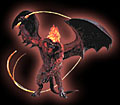 Lord of the Rings 24" Balrog with Sound
Lord of the Rings 24" Balrog with Sound
The most anticipated Lord of the Rings figure of all time! The Fire Demon Balrog is over 20" tall with a 3-1/2 foot wing span. Comes complete with sword and whip. This fully poseable figure includes ball jointed shoulders, bendable elbows, swivel wrists, and more. The eyes and flames on his back 'glow' with LED lights inside. (From the product description. Note that the red aura has been added for clarity against the black background and is not present in the actual product. Please read Amazon description and reviews before purchasing.)
Click
here
to buy this collectible.
 The Lord Of The Rings Fellowship Of The Ring 10" Sauron Deluxe
The Lord Of The Rings Fellowship Of The Ring 10" Sauron Deluxe
Rating:
    
The great evil who is seeking to rule Middle Earth has been masterfully crafted into a 10" action figure. Adorned in intricately detailed armor, Sauron features 16 points of articulation. He holds his evil mace and wears a shrouded back cape. Sauron wears "the one ring to rule them all," which is lost when his fingers are realistically severed. His eyes light up red as he electronically speaks four different phrases from the movie.
Click
here
to buy this collectible.
 The One Ring
The One Ring
Rating:
    
One Ring to Rule Them All. One Ring to Find Them,
One Ring to Bring Them All, And in the Darkness Bind Them!
The One Ring...Isildur's Bane, the Ring of Power...forged in the fires of Mount Doom by Sauron himself! Now you, too, can be a Ringbearer, if you dare...
Bearing the Black Speech of Mordor, transcribed into beautiful, flowing Elvish script which is laser engraved, these rings are reproductions of the One Ring you have seen in the movies, and are fully licensed by New Line. The Elvish script is both inside the rings as well as outside. Displayed in a rich wood treasure box, a certificate of authenticity accompanies this recreation of the One Ring to Rule Them All from The Lord of the Rings film trilogy. Now available in different sizes!
Click
here
to buy this collectible.
Editorial
|
Press Releases
|
Book Reviews
|
Fragments
Artifacts: The Exodus Revelation I
The Journey: Ireland I
|
Giants of Ireland
|
The Lord of the Rings Cipher I
Register
for our Hall of Records Newsletter
Questions? Comments? Suggestions? Advertising? Press Releases?
Contact us!
|

